Note
long distance or distanced partners - Person A staying up late and texting B all night. texts from 1 am, 3 am, and B either worrying over them about getting enough sleep, or laughing their ass off at their texts.
Oh this is so cute. I can so see the complete crack&lols texts turning into soft caring moments
-1:00am-
Person A: hey this made me think of us*sends meme* *sends meme*
Person B who is in a different time zone: LMAO! This one made me think of you *sends meme*
Person A: awwww babe <3 <3
Person B: ♥︎♥︎♥︎
Person B: ....wait isn’t it like 1 am in your zone??
-3:00am-
Person A: *sends frog video* they’re so smol!
Person B: my love... pls, you have classes in four hours... GO TO BED.
Person A: ........... *sends dancing frog* they’re dancing now.
*incoming call from Person B who’s prepared to listen to Person A talk until they can fall asleep*
58 notes
·
View notes
Text
“Your heart will stay forever when your last remains are few. In the dark we dance together and I’d like to be waiting with you.”
Latin: Tua cardia manebit in perpetua quando tuum ultimum remansum sit pauci. In tenebra saltamus simul et velim esse manens cum te.
Greek: ἡ σοῦ καρδία οἰκήσει διαμπερές πότε τὰ ἔσχατα λείψανα εἰσίν ὀλίγα. ἐν ἐπισκιῷ ἅμα χορεύομεν καὶ ἐρᾶν εἶναι ἐπέχειν μετά σοῦ.
— Gerard Way, Baby You’re a Haunted House (2018)
98 notes
·
View notes
Text
“Victory is an illusion of philosophers and fools.”
Latin: Victoria est illusio philosophorum et asinorum.
Greek: ἡ νίκη ἐστί ἡ πλάνη τῶν φιλοσόφων καὶ τῶν ὄνων.
—William Faulkner, The Sound and the Fury (1929)
57 notes
·
View notes
Text
Imagine Your Otp
Person A: Are you ever gonna look at me?
Person B: I already see you every time I close my eyes. Please don’t force me to look at you.
183 notes
·
View notes
Text
Person A: “I’m gonna miss you, man. Who am I gonna go on adventures with now?”
Person B: “I’m sure you’ll find a worthy replacement.”
330 notes
·
View notes
Text
super simple low-effort ao3 summary methods that are 1000% better and 1000% less annoying than just saying you suck at summaries:
copypaste the first few lines of the fic. u already wrote ‘em. let ‘em be their own damn hook
if ur feeling fancy & don’t mind showing ur hand a bit, copypaste the first few lines of the fic that u feel are esp. Important or Interesting - the ones where u first start getting into the real meat of things
state the main tropes! theyre probably already in ur tags - just say them again - maybe as a full sentence if ur feelin fancy. or with a joke if ur feelin Extra fancy
ask a question. pose a hypothetical. eg what happens if u take [character] and put them in [situation]?
make an equation. [character] + [thing] = [outcome]
just write like a one-sentence summary of what the fuck is going down. just one (1) sentence. doesnt matter if it doesn’t cover every important aspect. or if it sounds bland. any summary sentence is gonna be miles better than “idk i suck at summaries”
just…explain the fic like u would to a friend? it doesnt have to be a polished back of the book blurb. it can just be “[pairing] coffee shop au, but like, still with murder, and also i made everyone trans. enjoy”
just stick a meme in there
honestly who cares
just put literally anything but a self deprecating comment in there & ur golden
47K notes
·
View notes
Text
The creature that wants to kill you will not growl.
The function of a growl is as a warning. It is a communication that violence is available as a tool, but is not preferred. Other outcomes, besides your death, are available and should be considered.
But the creature that wants to kill you will not growl.
If your death is the goal, then growling will only serve as a delay and may result in your escape, which runs counter to the goal. There will be no growl, no warning. There will be no snarl or hiss or bluster. The creature that bares its teeth with the intent to kill only does so to bring closer its fangs to your demise.
The creature that growls does not want to kill you, but will if it must.
I advise you to appreciate the warning. You may not receive another.
66K notes
·
View notes
Text
some fucking resources for all ur writing fuckin needs
* body language masterlist
* a translator that doesn’t eat ass like google translate does
* a reverse dictionary for when ur brain freezes
* 550 words to say instead of fuckin said
* 638 character traits for when ur brain freezes again
* some more body language help
(hope this helps some ppl)
187K notes
·
View notes
Text
I have … a tip.
If you’re writing something that involves an aspect of life that you have not experienced, you obviously have to do research on it. You have to find other examples of it in order to accurately incorporate it into your story realistically.
But don’t just look at professional write ups. Don’t stop at wikepedia or webMD. Look up first person accounts.
I wrote a fic once where a character has frequent seizures. Naturally, I was all over the wikipedia page for seizures, the related pages, other medical websites, etc.
But I also looked at Yahoo asks where people where asking more obscure questions, sometimes asked by people who were experiencing seizures, sometimes answered by people who have had seizures.
I looked to YouTube. Found a few individual videos of people detailing how their seizures usually played out. So found a few channels that were mostly dedicated to displaying the daily habits of someone who was epileptic.
I looked at blogs and articles written by people who have had seizures regularly for as long as they can remember. But I also read the frantic posts from people who were newly diagnosed or had only had one and were worried about another.
When I wrote that fic, I got a comment from someone saying that I had touched upon aspects of movement disorders that they had never seen portrayed in media and that they had found representation in my art that they just never had before. And I think it’s because of the details. The little things.
The wiki page for seizures tells you the technicalities of it all, the terminology. It tells you what can cause them and what the symptoms are. It tells you how to deal with them, how to prevent them.
But it doesn’t tell you how some people with seizures are wary of holding sharp objects or hot liquids. It doesn’t tell you how epileptics feel when they’ve just found out that they’re prone to fits. It doesn’t tell you how their friends and family react to the news.
This applies to any and all writing. And any and all subjects. Disabilities. Sexualities. Ethnicities. Cultures. Professions. Hobbies. Traumas. If you haven’t experienced something first hand, talk to people that have. Listen to people that have. Don’t stop at the scholarly sources. They don’t always have all that you need.
103K notes
·
View notes
Text
Words for Skin Tone | How to Describe Skin Color
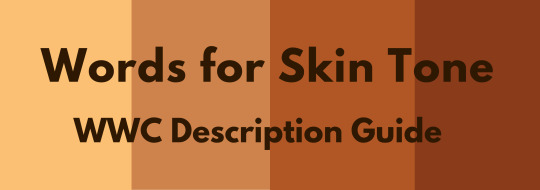
We discussed the issues describing People of Color by means of food in Part I of this guide, which brought rise to even more questions, mostly along the lines of “So, if food’s not an option, what can I use?” Well, I was just getting to that!
This final portion focuses on describing skin tone, with photo and passage examples provided throughout. I hope to cover everything from the use of straight-forward description to the more creatively-inclined, keeping in mind the questions we’ve received on this topic.
Standard Description
Basic Colors

Pictured above: Black, Brown, Beige, White, Pink.
“She had brown skin.”
This is a perfectly fine description that, while not providing the most detail, works well and will never become cliché.
Describing characters’ skin as simply brown or beige works on its own, though it’s not particularly telling just from the range in brown alone.
Complex Colors
These are more rarely used words that actually “mean” their color. Some of these have multiple meanings, so you’ll want to look into those to determine what other associations a word might have.

Pictured above: Umber, Sepia, Ochre, Russet, Terra-cotta, Gold, Tawny, Taupe, Khaki, Fawn.
Complex colors work well alone, though often pair well with a basic color in regards to narrowing down shade/tone.
For example: Golden brown, russet brown, tawny beige…
As some of these are on the “rare” side, sliding in a definition of the word within the sentence itself may help readers who are unfamiliar with the term visualize the color without seeking a dictionary.
“He was tall and slim, his skin a russet, reddish-brown.”
Comparisons to familiar colors or visuals are also helpful:
“His skin was an ochre color, much like the mellow-brown light that bathed the forest.”
Modifiers
Modifiers, often adjectives, make partial changes to a word.The following words are descriptors in reference to skin tone.
Dark - Deep - Rich - Cool
Warm - Medium - Tan
Fair - Light - Pale
Rich Black, Dark brown, Warm beige, Pale pink…
If you’re looking to get more specific than “brown,” modifiers narrow down shade further.
Keep in mind that these modifiers are not exactly colors.
As an already brown-skinned person, I get tan from a lot of sun and resultingly become a darker, deeper brown. I turn a pale, more yellow-brown in the winter.
While best used in combination with a color, I suppose words like “tan” “fair” and “light” do work alone; just note that tan is less likely to be taken for “naturally tan” and much more likely a tanned White person.
Calling someone “dark” as description on its own is offensive to some and also ambiguous. (See: Describing Skin as Dark)
Undertones
Undertones are the colors beneath the skin, seeing as skin isn’t just one even color but has more subdued tones within the dominating palette.
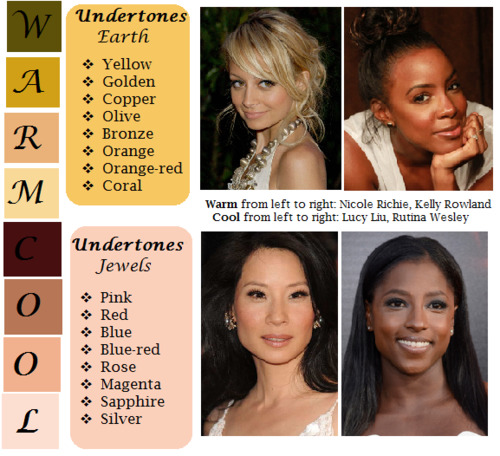
pictured above: warm / earth undertones: yellow, golden, copper, olive, bronze, orange, orange-red, coral | cool / jewel undertones: pink, red, blue, blue-red, rose, magenta, sapphire, silver.
Mentioning the undertones within a character’s skin is an even more precise way to denote skin tone.
As shown, there’s a difference between say, brown skin with warm orange-red undertones (Kelly Rowland) and brown skin with cool, jewel undertones (Rutina Wesley).
“A dazzling smile revealed the bronze glow at her cheeks.”
“He always looked as if he’d ran a mile, a constant tinge of pink under his tawny skin.”
Standard Description Passage
“Farah’s skin, always fawn, had burned and freckled under the summer’s sun. Even at the cusp of autumn, an uneven tan clung to her skin like burrs. So unlike the smooth, red-brown ochre of her mother, which the sun had richened to a blessing.”
-From my story “Where Summer Ends” featured in Strange Little Girls
Here the state of skin also gives insight on character.
Note my use of “fawn” in regards to multiple meaning and association. While fawn is a color, it’s also a small, timid deer, which describes this very traumatized character of mine perfectly.
Though I use standard descriptions of skin tone more in my writing, at the same time I’m no stranger to creative descriptions, and do enjoy the occasional artsy detail of a character.
Creative Description
Whether compared to night-cast rivers or day’s first light…I actually enjoy seeing Characters of Colors dressed in artful detail.
I’ve read loads of descriptions in my day of white characters and their “smooth rose-tinged ivory skin”, while the PoC, if there, are reduced to something from a candy bowl or a Starbucks drink, so to actually read of PoC described in lavish detail can be somewhat of a treat.
Still, be mindful when you get creative with your character descriptions. Too many frills can become purple-prose-like, so do what feels right for your writing when and where.
Not every character or scene warrants a creative description, either. Especially if they’re not even a secondary character.
Using a combination of color descriptions from standard to creative is probably a better method than straight creative. But again, do what’s good for your tale.
Natural Settings - Sky
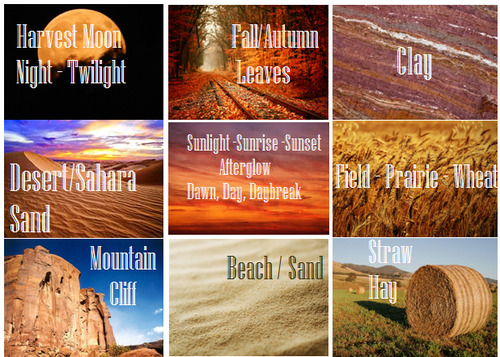
Pictured above: Harvest Moon -Twilight, Fall/Autumn Leaves, Clay, Desert/Sahara, Sunlight - Sunrise - Sunset - Afterglow - Dawn- Day- Daybreak, Field - Prairie - Wheat, Mountain/Cliff, Beach/Sand/Straw/Hay.
Now before you run off to compare your heroine’s skin to the harvest moon or a cliff side, think about the associations to your words.
When I think cliff, I think of jagged, perilous, rough. I hear sand and picture grainy, yet smooth. Calm. mellow.
So consider your character and what you see fit to compare them to.
Also consider whose perspective you’re describing them from. Someone describing a person they revere or admire may have a more pleasant, loftier description than someone who can’t stand the person.
“Her face was like the fire-gold glow of dawn, lifting my gaze, drawing me in.”
“She had a sandy complexion, smooth and tawny.”
Even creative descriptions tend to draw help from your standard words.
Flowers
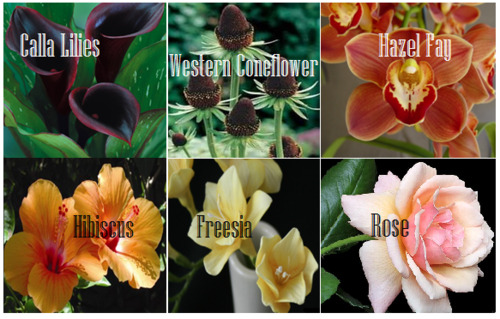
Pictured above: Calla lilies, Western Coneflower, Hazel Fay, Hibiscus, Freesia, Rose
It was a bit difficult to find flowers to my liking that didn’t have a 20 character name or wasn’t called something like “chocolate silk” so these are the finalists.
You’ll definitely want to avoid purple-prose here.
Also be aware of flowers that most might’ve never heard of. Roses are easy, as most know the look and coloring(s) of this plant. But Western coneflowers? Calla lilies? Maybe not so much.
“He entered the cottage in a huff, cheeks a blushing brown like the flowers Nana planted right under my window. Hazel Fay she called them, was it?”
Assorted Plants & Nature

Pictured above: Cattails, Seashell, Driftwood, Pinecone, Acorn, Amber
These ones are kinda odd. Perhaps because I’ve never seen these in comparison to skin tone, With the exception of amber.
At least they’re common enough that most may have an idea what you’re talking about at the mention of “pinecone.“
I suggest reading out your sentences aloud to get a better feel of how it’ll sounds.
“Auburn hair swept past pointed ears, set around a face like an acorn both in shape and shade.”
I pictured some tree-dwelling being or person from a fantasy world in this example, which makes the comparison more appropriate.
I don’t suggest using a comparison just “cuz you can” but actually being thoughtful about what you’re comparing your character to and how it applies to your character and/or setting.
Wood

Pictured above: Mahogany, Walnut, Chestnut, Golden Oak, Ash
Wood can be an iffy description for skin tone. Not only due to several of them having “foody” terminology within their names, but again, associations.
Some people would prefer not to compare/be compared to wood at all, so get opinions, try it aloud, and make sure it’s appropriate to the character if you do use it.
“The old warlock’s skin was a deep shade of mahogany, his stare serious and firm as it held mine.”
Metals

Pictured above: Platinum, Copper, Brass, Gold, Bronze
Copper skin, brass-colored skin, golden skin…
I’ve even heard variations of these used before by comparison to an object of the same properties/coloring, such as penny for copper.
These also work well with modifiers.
“The dress of fine white silks popped against the deep bronze of her skin.”
Gemstones - Minerals
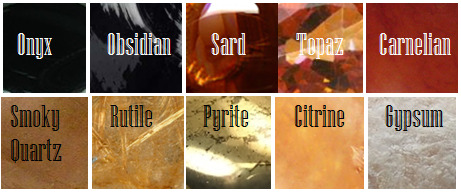
Pictured above: Onyx, Obsidian, Sard, Topaz, Carnelian, Smoky Quartz, Rutile, Pyrite, Citrine, Gypsum
These are trickier to use. As with some complex colors, the writer will have to get us to understand what most of these look like.
If you use these, or any more rare description, consider if it actually “fits” the book or scene.
Even if you’re able to get us to picture what “rutile” looks like, why are you using this description as opposed to something else? Have that answer for yourself.
“His skin reminded her of the topaz ring her father wore at his finger, a gleaming stone of brown, mellow facades.”
Physical Description
Physical character description can be more than skin tone.
Show us hair, eyes, noses, mouth, hands…body posture, body shape, skin texture… though not necessarily all of those nor at once.
Describing features also helps indicate race, especially if your character has some traits common within the race they are, such as afro hair to a Black character.
How comprehensive you decide to get is up to you. I wouldn’t overdo it and get specific to every mole and birthmark. Noting defining characteristics is good, though, like slightly spaced front teeth, curls that stay flopping in their face, hands freckled with sunspots…
General Tips
Indicate Race Early: I suggest indicators of race be made at the earliest convenience within the writing, with more hints threaded throughout here and there.
Get Creative On Your Own: Obviously, I couldn’t cover every proper color or comparison in which has been “approved” to use for your characters’ skin color, so it’s up to you to use discretion when seeking other ways and shades to describe skin tone.
Skin Color May Not Be Enough: Describing skin tone isn’t always enough to indicate someone’s ethnicity. As timeless cases with readers equating brown to “dark white” or something, more indicators of race may be needed.
Describe White characters and PoC Alike: You should describe the race and/or skin tone of your white characters just as you do your Characters of Color. If you don’t, you risk implying that White is the default human being and PoC are the “Other”).
PSA: Don’t use “Colored.” Based on some asks we’ve received using this word, I’d like to say that unless you or your character is a racist grandmama from the 1960s, do not call People of Color “colored” please.
Not Sure Where to Start? You really can’t go wrong using basic colors for your skin descriptions. It’s actually what many people prefer and works best for most writing. Personally, I tend to describe my characters using a combo of basic colors + modifiers, with mentions of undertones at times. I do like to veer into more creative descriptions on occasion.
Want some alternatives to “skin” or “skin color”? Try: Appearance, blend, blush, cast, coloring, complexion, flush, glow, hue, overtone, palette, pigmentation, rinse, shade, sheen, spectrum, tinge, tint, tone, undertone, value, wash.
Skin Tone Resources
List of Color Names
The Color Thesaurus
Skin Undertone & Color Matching
Tips and Words on Describing Skin
Photos: Undertones Described (Modifiers included)
Online Thesaurus (try colors, such as “red” & “brown”)
Don’t Call me Pastries: Creative Skin Tones w/ pics I
Writing & Description Guides
WWC Featured Description Posts
WWC Guide: Words to Describe Hair
Writing with Color: Description & Skin Color Tags
7 Offensive Mistakes Well-intentioned Writers Make
I tried to be as comprehensive as possible with this guide, but if you have a question regarding describing skin color that hasn’t been answered within part I or II of this guide, or have more questions after reading this post, feel free to ask!
~ Mod Colette
167K notes
·
View notes
Text
Color synonyms cheat-sheet
Here’s my ultimate list of synonyms for every colour that you can use in your descriptive writing! Save this post to find them easy later.
Red
scarlet
vermillion
ruby
blood
wine
cerise
crimson
cherry
maroon
coral
rust
sanguine
blush
burgundy
Blue
azure
cobalt
sapphire
cerulean
marine
navy
indigo
teal
denim
ocean
lapis
sky
turquoise
Yellow
amber
gold
lemon
sand
saffron
ivory
dandelion
honey
butterscotch
mustard
canary
flaxen
maize
Green
olive
emerald
grassy
verdant
sage
lime
pine
juniper
chartreuse
seafoam
moss
fern
jade
forest
Black
jet
obsidian
onyx
raven
charcoal
ink
shadowed
dark
midnight
grease
void
White
pearl
alabaster
egg shell
cotton
snow
ivory
frost
bone
powder
light
chiffon
cream
ashen
Orange
amber
tangerine
marigold
clay
apricot
peach
sandstone
honey
bronze
fire
ochre
titian
auburn
Purple & Pink
lavender
plum
lilac
violet
magenta
mauve
orchid
blush
fuschia
salmon
grape
mulberry
periwinkle
iris
Brown
chestnut
hazel
ginger
sepia
mahogany
cedar
cinnamon
beige
bronze
auburn
coffee
walnut
wood
umber
tawny
5K notes
·
View notes
Text

I don't know if adding color was a mistake T^T
16 notes
·
View notes
